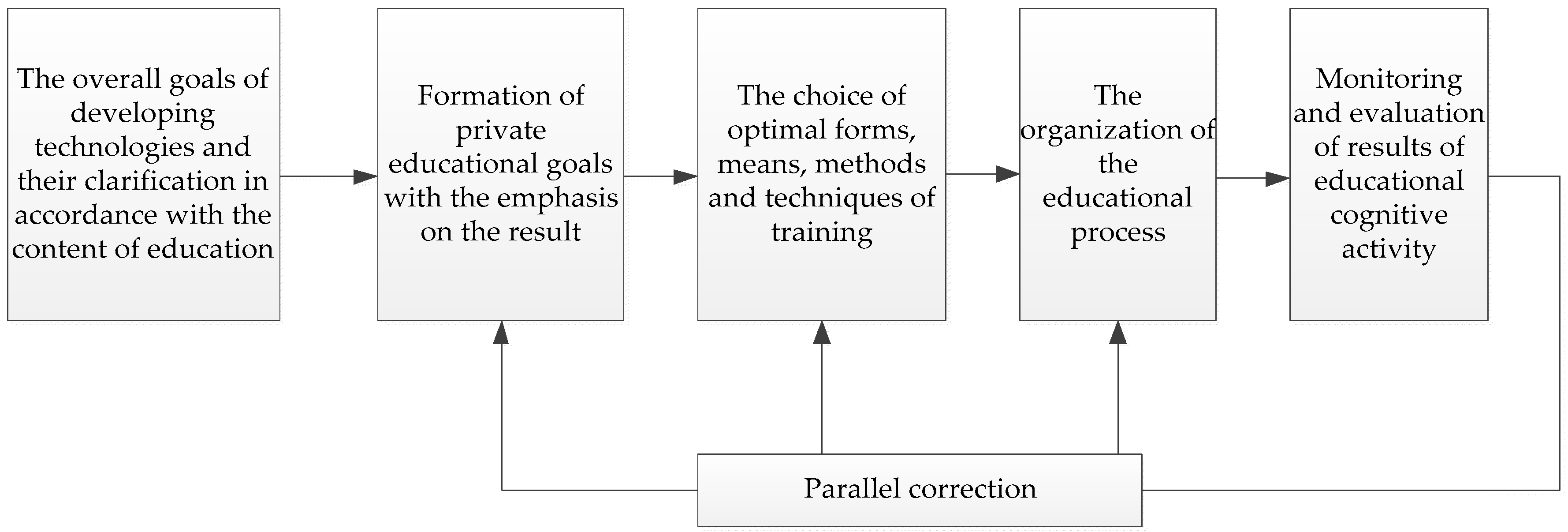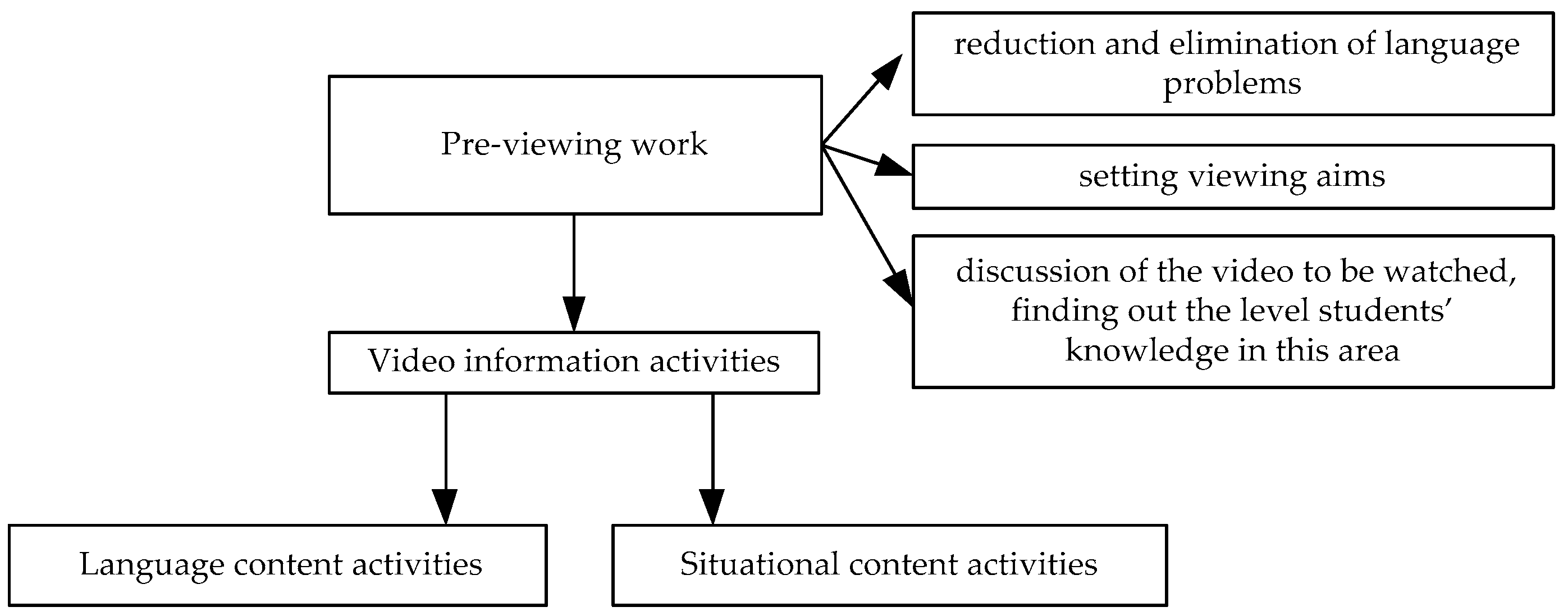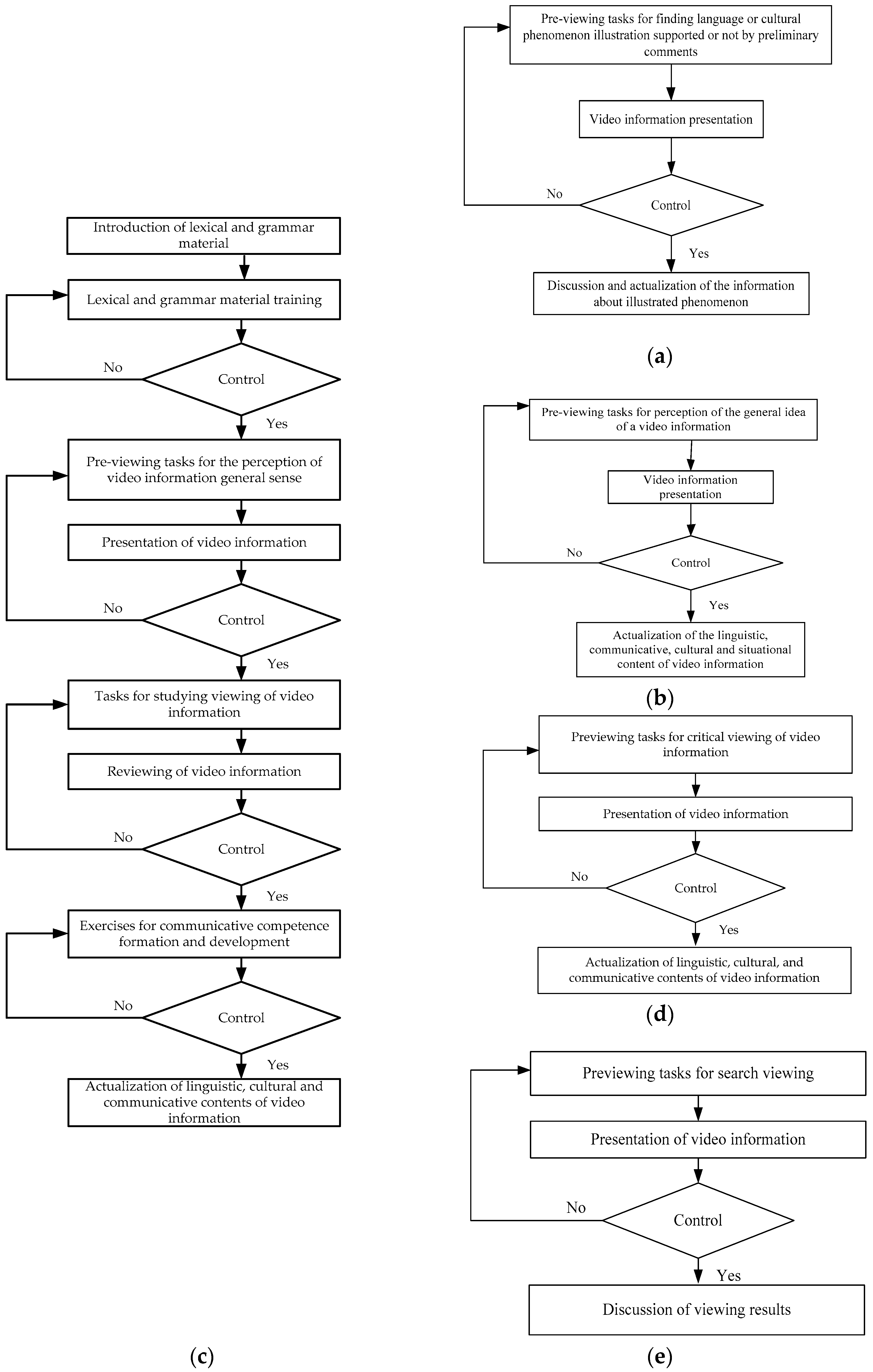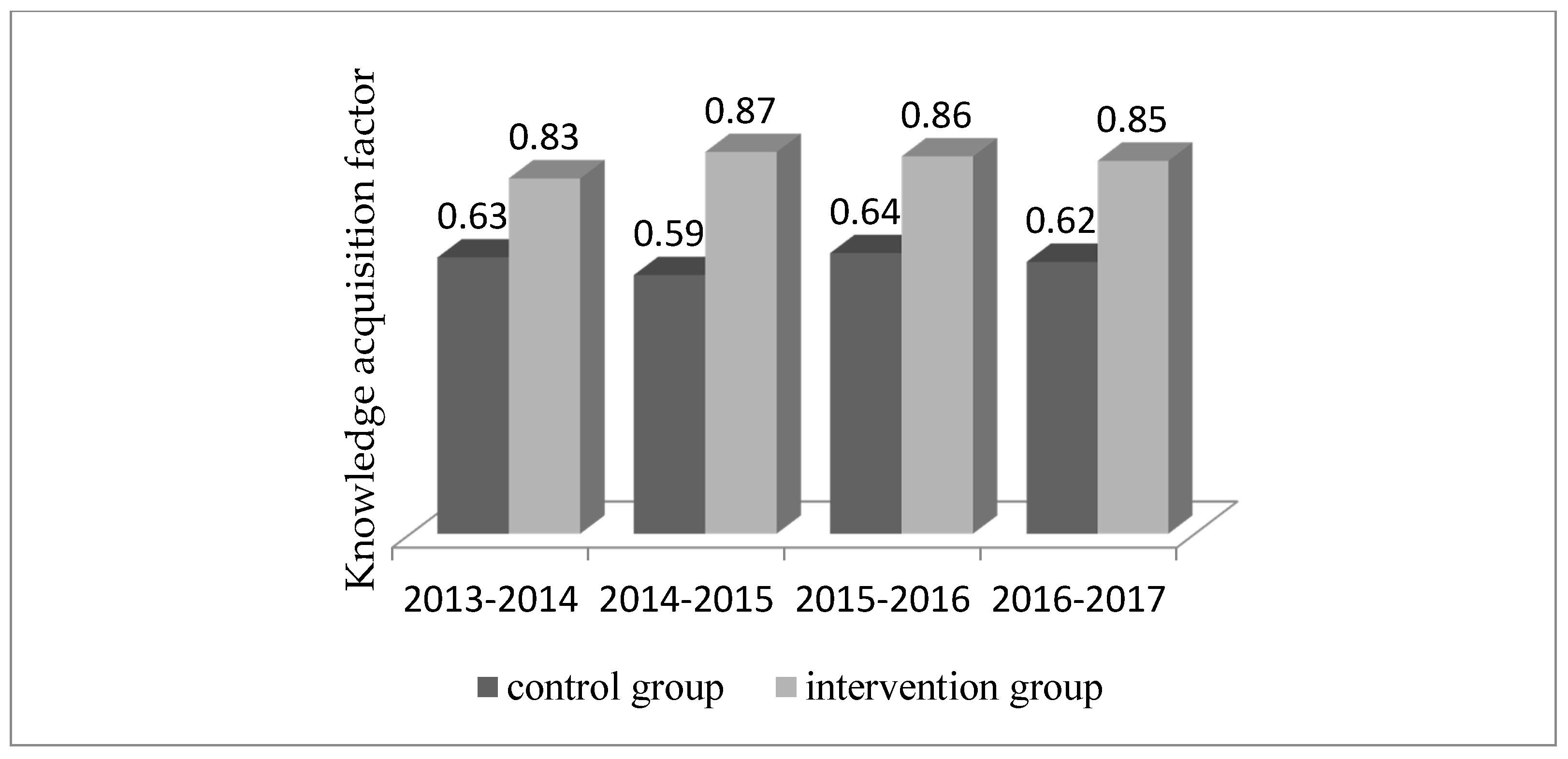Teaching a Foreign Language Using Videos
Abstract
:1. Introduction
2. Materials and Methods
2.1. Classification of Audiovisual Materials in Training a Foreign Language
2.2. Video Courses and Video Films
- Informative and training function—the student is involved in the film’s subject line and in the process of information transfer simultaneously; this information will be used in the course of training;
- Illustrative and evident function—video film shows a subject line in the art form;
- Organizational and operational—it is realized in concentration and the subsequent management of students’ attention by means of a subject line and art features of its embodiment;
- Educational—it is embodied in realization of certain ideas in the art form and statement of problems which the student will discuss further;
- Integrating—in the course of viewing there is a process of integration of various kinds of perceptions, and also various aspects of language—phonetic, lexical etc. (Pisarenko and Krasnoshchekova 2016).
- Preliminary work—preliminary removal of language and cultural difficulties, statement of an educational task;
- Perception—development of skills of the information perception;
- Control of understanding of the basic maintenance;
- Development of language skills and abilities of oral speech.
2.3. All Other Video Information
2.4. Pedagogical Algorithms of Audiovisual Technologies Realization
- The formulation of the global purpose of work and a specific goal of viewing and statement of an educational problem—what exactly should be made by students during presentation of a video information and after it?
- The formulation of the global purpose of work and a specific goal of viewing and statement of an educational problem, removal of lexical and grammatical difficulties, linguistic and cultural comments to a video information, having for an object the removal of difficulties of social and cultural character.
- Removal of difficulties assumes introduction of a new lexical and grammatical material, its training based on exercises, and the linguistic and cultural comment of the social and cultural phenomena that will appear in the course of viewing.
2.5. Making Your Own Video
3. Results
3.1. Baseline Characteristics
3.2. Foreign Language Communicative Competence
3.3. Knowledge Acquisition
4. Discussion
5. Conclusions
- the learner is considered to be a center of education process as actor, doer, creator, and interpreter of video; all education process is organized for learner and is aimed at formation and development of foreign language communicative competence;
- the teacher offers the learner video resources of different types in various forms and stages; they are selected by teacher and processed for being used in education process;
- the operational part of audiovisual technologies is realized by pedagogical algorithms; their selection is defined by purposes of education process;
- since learners (and teachers) are very different from one another, they need to be provided with a wide range of activities and stimuli;
- all text is produced by the students - when viewing they produce their own very particular, internal version of what is on the screen; when videoing they make all the decisions both behind and in front of the lens;
- even course book material can have life breathed into it by letting the students take it over and re-fashion it in their own special way;
- experimental research has shown the effectiveness of audiovisual technologies use in education process.
Conflicts of Interest
References
- Alava, Séraphin, and Etévé Christiane. 1999. Note synthèse. Revue Française de Pédagogie 127: 119–64. [Google Scholar] [CrossRef]
- Andrade, Rafael de Castro, and Carla Galvão Spinillo. 2013. Interactive and Animated Journalistic Infographics: Analytic Study about Infographics Health. Paper presented at 6th Information Design International Conference, Recife, Brazil, 10–13 September. [Google Scholar] [CrossRef]
- Arsaliev, Shavadi. 2015. New information technologies in ethnopedagogical process. Paper presented at 9th International Conference on Application of Information and Communication Technologies (AICT), Rostov-on-Don, Russia, 14–16 October. [Google Scholar] [CrossRef]
- Arsaliev, Shavadi. 2016. Ethnopedagogical Technologies: Best Approaches and Practices. Recent Patents on Computer Science 9: 173–84. [Google Scholar] [CrossRef]
- Babansky, Iurij Konstantinovich. 1973. Optimization of the Teaching Process. Russian Education & Society 15: 3–18. [Google Scholar] [CrossRef]
- Babansky, Yurij Konstantinovich. 1987. The Modernization of Educational Research Methods in the USSR. Prospects 17: 185–98. [Google Scholar] [CrossRef]
- Baguley, David, Andersson Gerhard, McFerran Don, and Laurence McKenna. 2013. Cognitive Behaviour Therapy. In Tinnitus: A Multidisciplinary Approach, 2nd ed. West Sussex: John Wiley & Sons, Ltd. [Google Scholar]
- Banner, Gloria, and Steve Rayner. 2000. Learning Language and Learning Style: Principles, Process and Practice. The Language Learning Journal 21: 37–44. [Google Scholar] [CrossRef]
- Bégin, C. 2008. Les stratégies d’apprentissage : Un cadre de référence simplifié. Revue Des Sciences de L’éducation 34: 47. [Google Scholar] [CrossRef]
- Brečka, Peter, and Miriam Bitterová. 2012. Technical Education Support in Pre-Primary Education by Interactive Teaching Systems. Acta Technologica Dubnicae. [Google Scholar] [CrossRef]
- Carterette, Edward C., and Morton P. Friedman. 1978. FOREWORD. In Handbook of Perception. Amsterdam: Elsevier Inc. [Google Scholar]
- Chavez, Alicia Fedelina, Florence Guido-DiBrito, and Sherry L. Mallory. 2003. Learning to Value the ‘Other’: A Framework of Individual Diversity Development. Journal of College Student Development 44: 453–69. [Google Scholar] [CrossRef]
- Corbalan, Montserrat, Emiliano Aldabas, Pou Josep, Zaragoza Jordi, Igual Raul, and Inmaculada Plaza. 2011. An Approach on How to Use Audiovisual Resources at Engineering Higher Education. Paper presented at Conference Promotion and Innovation with New Technologies in Engineering Education (FINTDI 2011), Teruel, Spain, 5–6 May. [Google Scholar] [CrossRef]
- Daniels, Shirley. 1994. The Learning Organization. Work Study 43: 5–6. [Google Scholar] [CrossRef]
- Deetman, Wilem Joost. 1989. New Technologies in Higher Education: Chaos or Progress? In Higher Education and New Technologies. Amsterdam: Elsevier, pp. 1–4. [Google Scholar]
- Fails, Eleanor V. 1988. Teaching Sociological Theory through Video: The Development of an Experimental Strategy. Teaching Sociology 16: 256. [Google Scholar] [CrossRef]
- Friedrich, Janette. 2001. Philosophie, psychologie et pédagogie : Un ménage à trois. In Le Pari des Sciences de L’éducation. Paris: De Boeck Superieur, p. 57. [Google Scholar]
- Kibalchenko, Irina Alexandrovna, and Eksakusto Tatiana Valentinovna. 2016. Descriptors of Successful Entrepreneurial Activity. Socio-Humanitarian Research and Technology 5: 41–6. [Google Scholar] [CrossRef]
- Kibalchenko, Irina Alexandrovna, and Alla Igorevna Zabalueva. 2017. Educational-Cognitive Competence as a Factor of Formation of Professional Competence of Students. Modern Problems of Science and Education. Available online: https://www.science-education.ru/ru/article/view?id=26243 (accessed on 16 October 2017). [CrossRef]
- Kibalchenko, Irina Alexandrovna, Tatiana Valentinovna Eksakusto, and Vitaly Sergeevich Kompaniets. 2015. Personality Profiles of Young People-Potential Entrepreneurs. Mediterranean Journal of Social Sciences. [Google Scholar] [CrossRef]
- Kitto, Kathleen L., and Sylvester Bernard. 2002. A Multidisciplinary Approach to Teaching Ethical Considerations in Engineering Technology. Paper presented at 32nd Annual Frontiers in Education, Boston, MA, USA, 6–9 November. [Google Scholar] [CrossRef]
- Kuhn, T. S. 1996. The Structure of Scientific Revolutions. Chicago: University of Chicago Press. [Google Scholar]
- Mitchell, Jeff. 1989. Video: Multifaceted tool or window on passivity. Educational Technology Research and Development 37: 97–8. [Google Scholar] [CrossRef]
- Mitchell, P. David. 1997. The impact of educational technology: a radical reappraisal of research methods. Research in Learning Technology. [Google Scholar] [CrossRef]
- Murphy, Kevin R. 2011. Individual Differences Can Both Facilitate and Limit Individual Development. Individual Differences and Development in Organisations (n.d.). Oxford Handbooks Online, 53–72. [Google Scholar] [CrossRef]
- Parker, Sue T. 1979. Mind in Society: The Development of Higher Psychological Processes. L. S. Vygotsky. American Anthropologist 81: 956–57. [Google Scholar] [CrossRef]
- Pisarenko, Veronika. 2015. Informational and Technological Support of Foreign Language Training in High School. Paper presented at 9th International Conference on Application of Information and Communication Technologies (AICT), Rostov-on-Don, Russia, 14–16 October. [Google Scholar]
- Pisarenko, Veronika, and Shavadi Arsaliev. 2016. Audiovisual technologies for foreign laguages teaching. Paper presented at IEEE 10th International Conference on Application of Information and Communication Technologies (AICT), Baku, Azerbajdgan, 10–14 October. [Google Scholar]
- Pisarenko, Veronika, and Maxim Bondarev. 2016. Infographics Use in Teaching Foreign Languages for Specific Purposes. Recent Patents on Computer Science 9: 124–32. [Google Scholar] [CrossRef]
- Pisarenko, Veronika, and Galina Krasnoshchekova. 2016. Video in Teaching. Paper presented at IEEE 10th International Conference on Application of Information and Communication Technologies (AICT), Baku, Azerbajdgan, 10–14 October. [Google Scholar] [CrossRef]
- Rieber, Robert W., and David K. Robinson. 2004. The Function of Signs in the Development of Higher Mental Processes. In The Essential Vygotsky. New York: Springer, pp. 539–50. [Google Scholar]
- Sanders, Christina. 2016. Teaching and Collaborating via Video Conference. Paper presented at Innovations in Teaching & Learning Conference, George Mason University, the USA, 15 July. [Google Scholar] [CrossRef]
- Soriano, Fernando I. 1995. SAGE Human Service Guide 68: Conducting Needs Assessments: A Multidisciplinary Approach. Thousand Oaks: SAGE Publications Ltd. [Google Scholar]
- Stempleski, Susan. 1989. Teaching English with Video. System 17: 109. [Google Scholar] [CrossRef]
- Stepin, Vyacheslav Semionovitch. 2007. Scientific Knowledge as Value of Modern Civilisation. In Technological and Environmental Policy. Glashütte: Nomos, pp. 19–40. [Google Scholar]
- Stepin, Vyacheslav Semionovitch. 2008. Types of Systems and Types of Scientific Rationality. SATS 9. [Google Scholar] [CrossRef]
- Stepin, Vyacheslav Semionovitch. 2009. Scientific Knowledge and Values of Technogenic Civilisation. In The Social Integration of Science. Glashütte: Nomos, pp. 35–68. [Google Scholar]
- Stover, William J. 1978. Student Video Stimulus and Changing Images of the Soviet Union: An Experimental Pilot Study of Video in Teaching International Relations. Teaching Political Science 5: 333–42. [Google Scholar] [CrossRef]
- Tight, Daniel G. 2010. Perceptual Learning Style Matching and L2 Vocabulary Acquisition. Language Learning 60: 792–833. [Google Scholar] [CrossRef]
- Vernadsky, V. I. 1998. The Biosphere. New York, NY, USA: Springer. [Google Scholar] [CrossRef]
- Vygotsky, Lev Semenovich. 1977. The Development of Higher Psychological Functions. Russian Social Science Review 18: 38–51. [Google Scholar] [CrossRef]
- Vygotsky, Lev, Cole Michael, John-Steiner Vera, Scribner Sylvia, and Souberman Ellen. 1979. Mind in Society. The Development of Higher Psychological Processes. The American Journal of Psychology 92: 166. [Google Scholar] [CrossRef]
- Wolfs, José-Luis. 2007. Méthodes de Travail et Stratégies D’apprentissage. Paris: De Boeck Supérieur. [Google Scholar]
- Zablotskaya, Oksana. 2014. Developing French for Specific Purposes Self-Study Support Materials for Mixed-Speciality Student Groups. Paper presented at SGEM 2014 Scientific SubConference on Psychology and Psychiatry, Sociology and Healthcare, Education, Bulgaria, 1 September. [Google Scholar] [CrossRef]
- Zankov, Leonid Vladimirovich. 1963. The Didactic Foundations of Teaching (Submitted for Discussion). Russian Education & Society 5: 3–12. [Google Scholar] [CrossRef]
- Zankov, Leonid Vladimirovich. 1964. Convincing Experience. Russian Education & Society 6: 3–6. [Google Scholar] [CrossRef]
- Zaporozhets, Alexandr, and David Elkonin. 1973. Dialectics and Development: Soviet Preschool Psychology. Human Development 16: 243–47. [Google Scholar] [CrossRef]







| Intervention Group (n = 25) | Control Group (n = 24) | |
| Average age (years) | 18.0 | 18.6 |
| Foreign language—English | 25 | 24 |
| Years of foreign language studies | ||
| 6 | 9 | 7 |
| 7 | 6 | 5 |
| 8 | 3 | 4 |
| 9 | 3 | 5 |
| 10 | 4 | 3 |
| Basic foreign language education | ||
| The Russian Federation | 23 | 23 |
| The Ukraine | 2 | 1 |
| Gender | ||
| male | 92 | 88 |
| female | 8 | 12 |
| Year of Groups Formation | Group | Average Factor of Mastering of the First Year of Studies | Average Factor of Mastering of the Second Year of Studies |
|---|---|---|---|
| 2013–2014 | Control | 0.62 | 0.63 |
| Intervention | 0.78 | 0.81 | |
| 2014–2015 | Control | 0.61 | 0.59 |
| Intervention | 0.85 | 0.87 | |
| 2015–2016 | Control | 0.63 | 0.64 |
| Intervention | 0.83 | 0.86 | |
| 2016–2017 | Control | 0.60 | 0.62 |
| Intervention | 0.79 | 0.85 |
© 2017 by the author. Licensee MDPI, Basel, Switzerland. This article is an open access article distributed under the terms and conditions of the Creative Commons Attribution (CC BY) license (http://creativecommons.org/licenses/by/4.0/).
Share and Cite
Pisarenko, V. Teaching a Foreign Language Using Videos. Soc. Sci. 2017, 6, 125. https://doi.org/10.3390/socsci6040125
Pisarenko V. Teaching a Foreign Language Using Videos. Social Sciences. 2017; 6(4):125. https://doi.org/10.3390/socsci6040125
Chicago/Turabian StylePisarenko, Veronika. 2017. "Teaching a Foreign Language Using Videos" Social Sciences 6, no. 4: 125. https://doi.org/10.3390/socsci6040125




